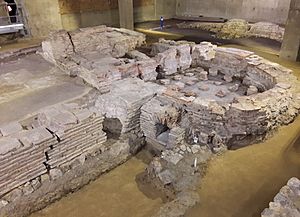Billingsgate Roman House and Baths facts for kids
The Billingsgate Roman House and Baths is an amazing ancient site found in Londinium, which was the Roman name for London. The most well-preserved parts of this old house are its Roman baths, which even had a special hypocaust system for heating the floors.
These ruins were first discovered way back in 1848. Workers found them while they were building the London Coal Exchange. Luckily, the people building it decided to keep the remains safe. They even made them visible in the basement of the new building! Later, between 1967 and 1970, the Coal Exchange building was replaced. More digging happened then, and the Roman remains were carefully moved into the basement of the new building. However, they are not usually open for everyone to visit.
Contents
What Was the Roman House Like?
Pottery found at the site tells us that this Roman house was built in the late 2nd century. That's a long time ago!
Early Design
When it was first built, the house had a north wing and an east wing. These parts were built around a central courtyard. It's thought there was probably a west wing too, but sadly, that part didn't survive.
At that time, the house was right on the edge of the Thames. Imagine living so close to the water! Some of the rooms in the east wing were very fancy. They had a special system called underfloor heating to keep them warm.
The Roman Baths
In the 3rd century, something exciting was added to the house. A whole bath complex was built right in the open courtyard!
- Cold Room (Frigidarium): This was a cool room where people could take a refreshing dip in cold water. On old maps, this part is often shown in blue.
- Warm Room (Tepidarium): After the cold room, people would move to a warm room. This helped their bodies get used to the heat before the hottest room. On maps, this is usually pink.
- Hot Room (Caldarium): This was the hottest room, like a sauna, where people would sweat and clean themselves. On maps, you'll often see this marked in red.
How Long Was It Used?
The entire house and bath complex was used for a very long time, right up until the early 5th century. During the excavations, hundreds of coins from the late 4th century were found.
This is really important because it helps us understand more about the end of Roman rule in Britain. Finding a large building like this still being used in the early 5th century shows that Roman life continued for a while. However, it seems the house was probably already in ruins by the year 500. An Anglo-Saxon brooch was even found among fallen pieces from the roof, showing new people were living there after the Romans.
Gallery
Images for kids














